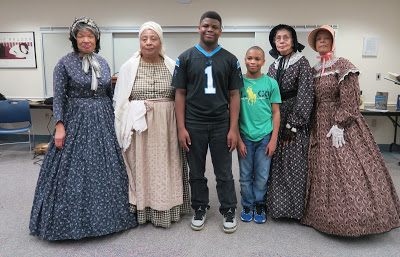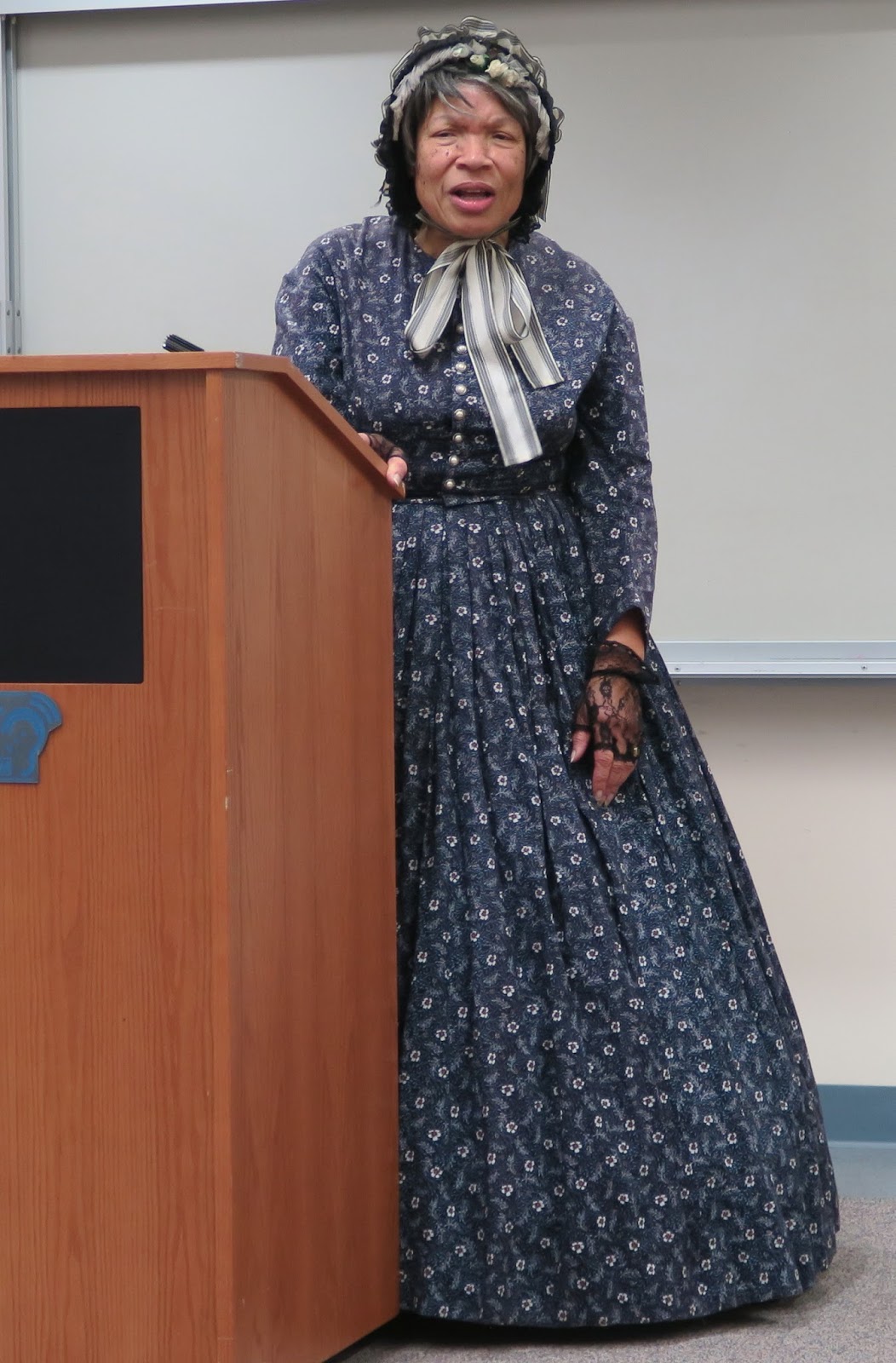African American women of the past appear at Annandale library
 |
| From the left: Patricia Tyson, Bobbie Coles, Cavon Dixon, Jeremiah Brown, Carol Gordon, and Judy Williams. |
Frances Ann Rollin was a writer who scored an early civil rights victory. Hallie Quinn Brown was a leader in education and women’s rights. Elizabeth Taylor was an accomplished singer, and Hattie was a slave who lived in obscurity.
The stories of those African American women of the 19th century were brought to life by a group called Female RE-Enactors of Distinction (FREED) at George Mason Regional Library Feb. 25.
FREED is based at the African American Civil War Museum in Washington, D.C. The group’s performance in Annandale focused on educating the public about the lives of women not generally covered in textbooks.
Two young students in the audience, Jeremiah Brown, a fifth-grader at Columbia Elementary School, and his brother Cavon Dixon, a sixth-grader at Holmes Middle School, are making a video about the re-enactors for the American History Film Project, founded by Martha Barnes, an aide at Columbia.
FREED member Carol Gordon portrayed Frances Ann Rollin, who was born in South Carolina in 1845. Her father, who had been freed from slavery, owned a successful lumberyard and was able to provide a good education for Ann and her four sisters, although he lost his business during the Civil War.
While Frances was working as a teacher in Charleston, she bought a first-class ticket for a riverboat, but when she boarded was forced to sit in the lower-level. That was insulting, so she filed a lawsuit and actually won in court. The boat captain was ordered to pay her $250, a huge amount of money in those days. It was the first victory under a civil rights act passed after the Civil War.
 |
| Patricia Tyson as Hallie Quinn Brown. |
Frances always loved to write and kept a journal, Gordon said. A biography she wrote, The Life and Public Services of Major Delaney, became the first book in the United States written by an African American woman, although the author is listed as “Frank,” because books by women wouldn’t sell.
After an unhappy marriage, Frances relocated to Washington, D.C., with her children where she worked for the abolitionist and author Frederick Douglass.
Hallie Quinn Brown, portrayed by Patricia Tyson, was a teacher, author, public speaker, and community activist. Her father was a slave on a plantation in Frederick, Md., who bought his freedom, moved his family to Pittsburgh, and worked to free others as part of the underground railroad.
The Quakers later smuggled the family to Canada, where Hallie saw Queen Victoria in a parade. After graduating from college, she taught in schools for blacks in Mississippi, served as dean of women at Tuskegee University in Alabama, then opened a school in Ohio for blacks from the South.
She got involved in the women’s suffrage movement, working with Susan B. Anthony, and went to England to raise money, where she actually met Queen Victoria.
Judy Williams presented the story of Elizabeth Taylor, who was born to a slave in 1917 in Natchez, Miss. Her mistress became a Quaker and shipped off Taylor’s parents and other slaves to the new country of Liberia and took Elizabeth to Philadelphia to serve as her housekeeper.
Elizabeth often sang while she worked, and a physician who lived next door heard her through an open window and paid for music lessons for her. Elizabeth learned to play the piano and guitar and sang at large social gatherings in all the free states of the North.
Her manager arranged for her to perform in England, but once there he took off with all her money, leaving her stranded and broke. The author Harriet Beecher Stow came to her rescue by introducing her to Queen Victoria’s organist, who arranged for her to perform all over Europe and, eventually, for the queen.
Elizabeth moved to Philadelphia where she continued to perform and teach music and was known as the “black swan.” George Handy, “the father of the blues” and founder of the first black-owned recording company, named it Black Swan after her.
Bobbie Coles appeared as “Hattie,” a slave who doesn’t know her age or even her real name. “The last time I saw my mother, I was sent to get water and never came back,” she told the audience. That was in Africa. She was captured and put on a ship to America, where she was bought and sold four times over the course of her life.
“I ain’t no slave. I was captured, stolen, and enslaved. I never seen them beat cattle the way they beat their slaves,” she says of her masters, who treat her as if she is “never a woman, always a thing.”
All 10 of her children were sold, including her youngest who was no more than 6 years old. As the Civil War got closer, Hattie had hopes her sons ran off to fight for the “blue coats.”
While Hattie’s story is based on historical records and journals, the other women presented by FREED are all real people whose stories were researched by the members of the group.


Nice, I love this kind of live history. Great community building.